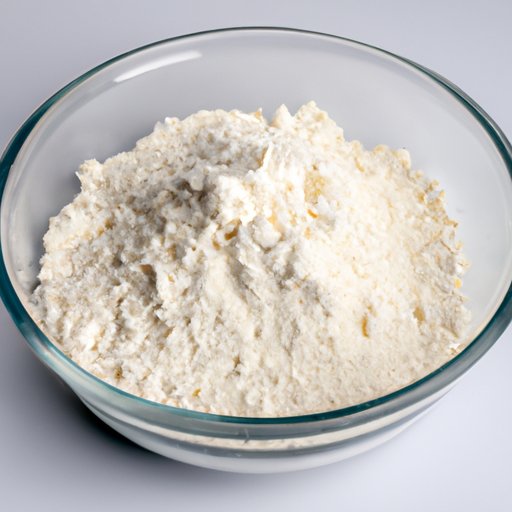
Can You Use All Purpose Flour Instead of Bread Flour?
Bread is a staple around the world, and bread-making has been a cherished tradition for generations. But what happens when you’re out of bread flour? Do you need to rush to the store, or is all-purpose flour a suitable substitute? This article explores the possibility of using all-purpose flour instead of bread flour. We will also delve into the science of flour and how it affects the final product. Whether you’re a beginner or an experienced baker, this article will help you get your bread fix without trekking to the store.
Baking 101: Understanding the Difference Between All-Purpose Flour and Bread Flour
All-purpose flour and bread flour are the most commonly used flours for baking. All-purpose flour is a blend of high-gluten hard wheat and low-gluten soft wheat. Bread flour, on the other hand, is a higher protein flour, usually made from hard wheat. The protein in flour determines its gluten content, which is essential for the structure and texture of bread.
The gluten in bread flour is approximately 12-14%, while all-purpose flour has around 10-12% gluten content. This difference in protein content is what sets these two types of flour apart from each other. Bread flour has a higher gluten content, which means it can absorb more liquid and yield a chewier and more resilient texture. All-purpose flour is best suited for lighter and fluffier baked goods like cakes or muffins.
Bread Baking Hacks: Substituting All-Purpose Flour for Bread Flour
The main challenge of using all-purpose flour instead of bread flour is the difference in gluten content. However, all is not lost. Several hacks can help you achieve a similar result. One option is to add vital wheat gluten to your all-purpose flour. Vital wheat gluten is a concentrated source of gluten that can be used as a substitute for bread flour. Adding it to all-purpose flour can increase its protein content to match that of bread flour.
Another option is to increase the protein content of all-purpose flour by combining it with other high-protein flours such as semolina, chickpea flour, or spelt flour. This can also help you achieve similar results to using bread flour.
Saving Money in the Kitchen: Using All-Purpose Flour in Place of Bread Flour
Bread flour tends to be more expensive than all-purpose flour. One of the main benefits of using all-purpose flour instead of bread flour is its cost-effectiveness. All-purpose flour is also readily available, making it a more convenient option than having to go out of your way to find bread flour. Furthermore, using all-purpose flour in place of bread flour can help reduce food waste. Instead of buying a specific flour for a particular recipe and having it sit unused in your pantry, use up what you have on hand to save money.
Here are some recipes where all-purpose flour can be substituted for bread flour:
- Pizza dough – Replace bread flour with an equal amount of all-purpose flour, and add a little extra yeast to compensate for the lower gluten content.
- Sandwich bread – Replace up to half of the bread flour with all-purpose flour for a lighter texture.
Swap It Out: The Pros and Cons of Substituting All-Purpose Flour for Bread Flour
Like most things in life, there are pros and cons to substituting all-purpose flour for bread flour in bread recipes. One of the biggest concerns is texture. Using all-purpose flour instead of bread flour can make your bread less chewy and resilient. All-purpose flour also tends to produce flatter loaves due to the lower protein content. However, all-purpose flour can work just as well, especially in lighter bread varieties such as sandwich bread or dinner rolls. It also tends to yield a more delicate crumb and texture.
The Best Recipes for Using All-Purpose Flour Instead of Bread Flour
Here are some of the best recipes that use all-purpose flour instead of bread flour:
- Honey Wheat Bread – Replace half of the bread flour with all-purpose flour to achieve a lighter texture
- Banana Bread – All-purpose flour produces a tender crumb in banana bread. Replace bread flour entirely with all-purpose flour.
- Cinnamon Rolls – Replace the bread flour with an equal amount of all-purpose flour for a more delicate texture.
The Science of Flour: Understanding the Chemistry of All-Purpose Flour and Bread Flour
Science plays a major role when it comes to baking. Understanding the chemistry of flour can help you improve your baking and create outstanding baked goods. The protein in flour is gluten-forming, which is essential in bread-making. All-purpose flour produces a weaker gluten than bread flour. This means that bread made with all-purpose flour will have less structure and a flatter loaf. Bread flour has more protein, and thus absorbs more liquid, which leads to a more substantial and chewy loaf.
Cooking Without Limits: Experimenting with All-Purpose Flour in Bread Recipes
In conclusion, using all-purpose flour instead of bread flour is possible. It requires some adjustments to your recipe, but with a few hacks and tips, you can achieve decent results with all-purpose flour. Experiment with the different recipes mentioned in this article and see how it changes your final product. Don’t be afraid to try baking with what you have on hand, and remember that with practice, you can become a baking pro no matter what type of flour you use.




